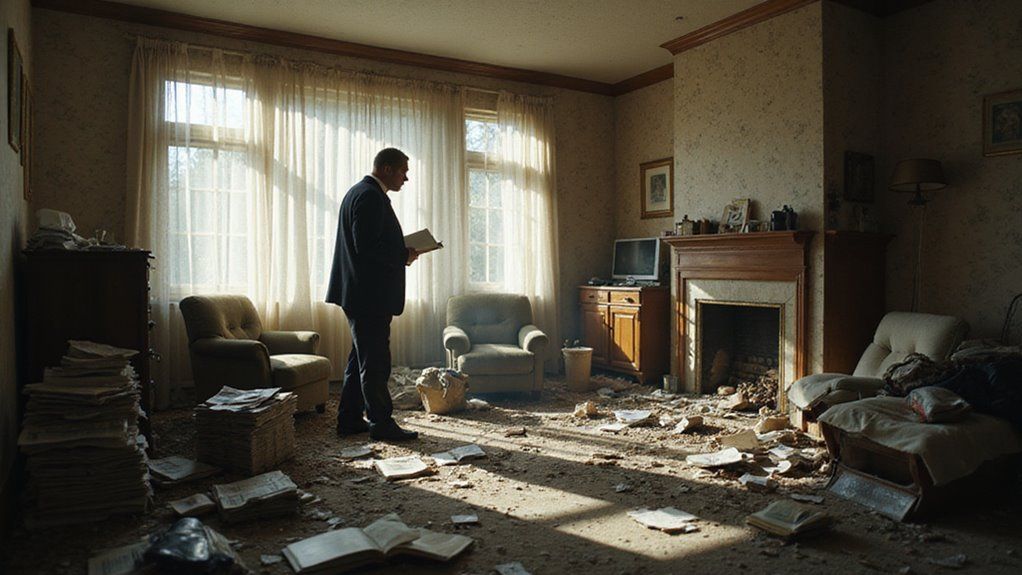How to Sell a Hoarder House As-Is Vs With Repairs

Selling a hoarder house can be overwhelming. You must choose between selling it as-is or making repairs first. This choice affects your time, money, and stress levels.
The problem gets worse if you don’t know what buyers want. Repairs might make the house sell for more, but they cost time and money. Selling as-is is faster, but you might get less.
The best way to sell a hoarder house depends on your goals, budget, and timeline. Weigh the pros and cons before you decide. Both options can work if you plan carefully.
This blog will guide you through each choice so you can make the best decision for your situation.
Key Takeaways
- Selling as-is is faster and less stressful but usually results in a lower sale price due to visible damage and limited buyer interest.
- Making repairs before selling attracts more buyers, increases sale price, and shortens time on market by improving property appeal.
- As-is sales are best for sellers wanting minimal effort, often targeting investors or cash buyers willing to handle repairs themselves.
- Repairing major issues like mold, pests, or structural damage can provide a higher return on investment if the local market supports higher prices.
- Always disclose all known issues and consider professional inspections to avoid legal problems and build trust with buyers regardless of selling strategy.
Understanding the Challenges of Selling a Hoarder House
Selling a hoarder house comes with special challenges. The process is not the same as selling a typical home. Buyers often have concerns about clutter and property condition.
Staging a hoarder house is difficult if rooms are full. Potential buyers cannot see the home’s features or layout. This can lower interest and offers.
Sorting through belongings can be stressful if you have an emotional connection. Many people feel guilt or sadness during this process. Emotional stress can delay decisions and slow down the sale.
If you understand these challenges, you can plan better. Preparation helps you handle both emotional and practical issues. This makes selling a hoarder house more manageable.
Additionally, flexible closing dates can be beneficial in coordinating the sale with your emotional and logistical needs. Recognizing the property condition and addressing it with a strategic approach can also ease the process and attract more offers.
Assessing the Condition of the Property
You need to check the property’s condition before deciding how to sell a hoarder house. Start with a full walkthrough and write down any damage you see. Take clear photos to show issues like mold, pests, or structural problems.
Accurate notes help you know what repairs are needed. If you guess wrong, you could lose money on the sale. Compare your house to similar homes in your area.
A market analysis shows what buyers expect for homes in your house’s condition. This helps you see what your house might sell for now or after repairs. If you know the true state of the property, you can decide whether to sell as-is or fix it first.
Additionally, understanding tenant occupancy and legal considerations can influence your decision on whether to sell immediately or wait for tenants to vacate, especially if the property is currently leased. Being aware of ownership rights can also impact how you approach the sale process.
Legal and Disclosure Requirements
When selling a hoarder house, you must follow strict legal and disclosure requirements that protect both you and the buyer. You'll need to provide mandatory seller disclosures, address hazardous material regulations, and ensure the property meets local code compliance.
Failing to handle these obligations properly can lead to costly disputes or delays in closing. Additionally, understanding title and ownership documentation is crucial to verify rightful ownership and prevent legal disputes. It's also important to be aware of court oversight processes that may impact the sale if the property is involved in legal proceedings.
Mandatory Seller Disclosures
Mandatory seller disclosures are required by law when selling a home. You must tell buyers about any problems that could affect the home’s value or safety. These problems may include damage, plumbing issues, or past pest infestations.
If you do not give full and accurate disclosures, you could face lawsuits or a canceled sale. Sellers must be honest about the home’s condition, even if selling as-is. Full disclosure helps protect you from future legal problems.
You should take time to record all important facts about the home. If you are unsure about what to include, ask a real estate agent or lawyer. Accurate disclosures build trust with buyers and help the sale process go smoothly.
Hazardous Material Regulations
You must follow hazardous material rules when selling a hoarder house, even if you sell it as-is. Laws require you to tell buyers if the home has things like asbestos, lead paint, or mold. If you do not share this information, you could face legal trouble.
Buyers have the right to know about any hazardous materials before they buy the home. If you hide this information, the sale could be canceled or you could be sued. Full honesty protects you and helps make the sale go smoothly.
You should hire experts to check for environmental hazards. If inspectors find problems, they can give you written proof. This documentation builds trust and keeps the transaction legal.
Local Code Compliance
Local building codes and disclosure laws are important when selling a hoarder house. If you do not follow them, you could face penalties or lose a sale. All sellers must share honest information about the property and its condition.
Waste management rules may require you to remove hazardous or extra waste before selling. Property maintenance codes set minimum standards for safety and livability. If your house does not meet these standards, you must fix the issues or inform buyers.
Sellers are legally required to disclose known problems or violations to buyers. Some repairs may require permits, even if they are minor. Obtaining proper permits helps prevent disputes after the sale.
If you follow these steps, you can avoid legal trouble and protect your interests. Compliance also makes the sale process smoother for everyone involved.
Evaluating the Local Real Estate Market
To make the smartest decision, you need to assess how property values in your neighborhood have shifted and where they're headed. Analyze recent buyer activity to gauge whether demand favors quick as-is sales or homes with updates. Reviewing comparable sales gives you a clearer picture of what buyers are actually paying for similar properties, helping you set realistic expectations.
Understanding the current ownership documentation requirements ensures you follow legal procedures for a smooth sale process. Additionally, considering the market conditions can help determine whether a traditional sale or a cash offer might be more advantageous in your situation.
Neighborhood Property Value Trends
Neighborhood property value trends show how much homes are selling for in your area. These trends affect your possible sale price and how many buyers may be interested. If you know the trends, you can better decide how to sell a hoarder house.
Compare your house to others nearby to see what they sold for recently. Look at how long homes usually stay on the market. Check if prices have been going up, down, or staying the same over the past six months.
If you notice homes in poor condition sell for much less, fixing your house may help. If most homes sell quickly as-is, repairs may not be needed. Always use recent sales data to guide your decision.
Buyer Demand Analysis
Buyer demand shows how many people want to buy homes like yours right now. It is important to know how fast similar homes are selling. This helps you see if there are more buyers or more sellers.
If many buyers are looking, you may not need to fix up your home much. You can sell your hoarder house as-is and focus on marketing to investors. High demand can make your sale easier.
If demand is low, you may need to do more work. Cleaning and fixing important areas can help attract more buyers. Basic repairs or decluttering can make your home more appealing.
You should always base your decisions on current demand, not just past sale prices. Real-time data helps you plan your selling strategy. This will guide how much effort or money you need to spend.
Comparable Sales Insights
Comparable sales, or "comps," help you decide how to price your hoarder house. Comps show what buyers paid for similar homes nearby. If you check comps, you can set a fair and realistic price.
You should look for homes with similar size, age, and lot. If a comp had repairs or pest control, note that. The condition of these homes often affects how fast they sold.
Homes that were clean and organized often sold faster. If a comp lingered on the market, it may have needed repairs. Compare the final sale price to the listing price to see what buyers are willing to pay.
If you study these details, you can choose to sell as-is or make repairs. Comps give you clear information for your decision. This way, you can plan the best selling strategy.
Calculating the Cost of Repairs
You need to know the possible repair costs before deciding to sell a hoarder house as-is or after repairs. Accurate cost estimates help you understand what needs fixing and how much you might spend. If you skip this step, you could face unexpected expenses later.
Professional inspections can reveal hidden issues, such as structural damage or plumbing problems. You should always get these inspections for a reliable budget. Missed problems may increase your costs after you start repairs.
Understanding downsizing motivations can also influence your decision, as some motivations prioritize quick sales over extensive repairs.
Break down the costs into categories for better planning.
A detailed cost breakdown lets you see where your money will go. If you know the costs ahead of time, you can plan your next steps more easily. This approach helps avoid surprises during the selling process. Moreover, understanding property condition can influence whether you choose to sell as-is or invest in repairs.
Weighing the Benefits of Selling As-Is
Selling a hoarder house as-is can offer clear benefits. This method lets you avoid cleaning, organizing, or staging the home. If you want a simple sale, this option can save time and effort. You can often sell the home faster since buyers expect it to need work. If you do not make repairs, you avoid spending extra money.
Investors often look for as-is homes to fix up. If you choose to sell as-is, you may also benefit from the quick sale process offered by cash buyers, which can significantly reduce the time your property stays on the market.
These cash buyers are typically willing to handle various issues, including code violations, making the process even smoother. If you sell as-is, you may also feel less stress. Sorting through personal items can be emotional and tiring. Selling quickly can make the whole process easier for you.
Potential Drawbacks of Selling As-Is
When you choose to sell a hoarder house as-is, you’ll likely face a lower sale price because buyers factor in the cost of repairs. Expect a smaller pool of interested buyers, since many people aren’t willing to take on major cleanup and renovation projects.
This limited demand can mean your property sits on the market longer than you’d like. Additionally, the price it right strategy is crucial to attract cash buyers who are prepared to handle the property's condition. Properly disclosing flood damage and repairs can also build trust and avoid legal issues during the sale process.
Lower Sale Price
Selling a hoarder house as-is usually means accepting a lower sale price. Buyers expect discounts because they must handle repairs and cleanup. You should plan for a smaller profit compared to selling a renovated home.
Buyers lower their offers when they see neglect or needed repairs. Appraisers might give the house a lower value due to its condition. If you sell to investors, they often offer less because they seek bargains.
The stigma of hoarding can scare away buyers or limit higher offers. If you want a quick sale with less effort, a lower price is likely. Consider these points before deciding to sell your home as-is.
Limited Buyer Pool
Selling a hoarder house as-is means you will have fewer potential buyers. Most homebuyers avoid homes with clutter or visible damage. If you want a quick sale, your choices are even more limited.
Many buyers find it hard to imagine living in a cluttered home. Some feel uncomfortable with the amount of stuff left behind. If the house needs repairs, buyers may lose interest quickly.
Investors or cash buyers are usually your main audience. Even they might hesitate if the problems seem too big. Less competition means buyers have more power to negotiate.
If you want a better price, you may need to make repairs or clean the house. Otherwise, you should expect more demands from buyers. The stigma of a hoarder house can make selling slower and harder.
Longer Timeframe Possible
Selling a hoarder house as-is usually takes longer to close. Buyers often hesitate when a home needs significant repairs. The property may stay on the market for many months.
Potential buyers need more time to check the home’s true condition. Multiple inspections may be necessary before they make an offer. This can add weeks or even months to the process.
Lenders might be slow to approve loans for homes in bad shape. Some may even deny financing altogether. This limits your pool of potential buyers.
Marketing a hoarder house is harder without repairs or staging. Fewer buyers may show interest, so offers take longer to arrive. If you skip repairs, expect a longer selling process.
Advantages of Making Repairs Before Selling
Making repairs before selling a hoarder house makes it easier to attract buyers. Fixed homes often sell faster and for more money. If you want a smooth sale, repairs are a smart step.
Repairs before selling a hoarder house help attract buyers and make the sale process smoother and more profitable.
Additionally, home staging can enhance the property's appeal by showcasing its best features and helping buyers envision living there.
Buyers prefer homes that are clean and ready to move into. Minor updates and repairs can make rooms look bigger and more welcoming. If the house looks cared for, buyers feel more confident.
Curb appeal matters because it creates a good first impression. A tidy exterior can bring more people to see the house. If more buyers visit, you may get better offers.
Repairing damage shows you have maintained the property. This can help buyers trust the home’s condition. If buyers trust the home, they may offer more.
Common Repairs Needed in Hoarder Houses
When preparing a hoarder house for sale, you’ll need to address key repairs like assessing structural damage, fixing outdated plumbing and electrical systems, and handling mold or pest infestations.
These issues often hide beneath clutter and can significantly affect your property’s value and safety. Tackling them upfront helps you attract serious buyers and avoid surprises during inspections.
Structural Damage Assessment
A structural damage assessment checks if the house is safe and stable. Hoarder houses often hide serious problems under clutter. You should inspect the structure before choosing to sell or repair.
The foundation is the first area to check. Look for cracks, uneven floors, or signs of shifting. These issues can affect the entire house.
Walls that support the house must also be checked. Watch for bowing, water spots, or warping. If you see these, the walls may be weak.
The roof is another key area to inspect. Sagging or leaks could mean structural damage. Damaged beams are another warning sign.
Floor joists need careful examination. Look for rot, insect damage, or bending. This helps you know the extent of repairs needed.
If you find problems in these areas, you may face high repair costs. Knowing the damage helps you decide whether to sell as-is or fix the house. Proper assessment prevents surprises later.
Plumbing and Electrical Issues
Plumbing and electrical issues in hoarder houses can be serious and affect your ability to sell. Clutter often blocks pipes and wires, hiding leaks or faulty outlets. These hidden problems can lower your home’s value and make selling harder.
If you sell as-is, buyers may offer less money because of possible repairs. If you fix these issues first, you may attract more buyers and get a better price. Consider the repair costs before deciding.
Professional inspections can uncover hidden plumbing or electrical faults. If you fix or honestly disclose these issues, you build trust with buyers. This approach can help prevent last-minute problems during the sale.
Mold and Pest Remediation
Mold and pest problems are common in hoarder houses. These issues can lower your property value and scare away buyers. If you want to sell, fixing mold and pest problems is very important.
A thorough inspection can help you find hidden mold in walls, floors, or ceilings. Mold often grows where there is moisture or neglect. If you find mold, professional help is usually needed to remove it safely.
Pests like insects and rodents are also common in hoarder homes. Pest control services can treat and remove these infestations. Keeping records of these repairs can give buyers confidence in your property.
If you ignore mold or pests, your home could sell for much less. Taking care of these problems increases your chances of selling at a good price. Buyers are more likely to consider homes that are clean and safe.
Estimating Return on Investment for Repairs
To know if repairs are worth it, compare the cost with the possible profit. Repairs should only be done if they increase your net gain. If not, selling as-is might be better.
Start by listing all needed repairs, such as cleaning and staging. Then, check recent sales of similar homes in your area. If repairs will raise your sale price more than they cost, consider fixing up the house.
Emotional appeal can help sell faster, but it needs time and money. If you do not have enough funds, selling as-is can be smarter. Always use clear numbers and local sales data to guide your choice.
Attracting Buyers for an As-Is Sale
Selling a hoarder house as-is attracts buyers who see potential, not perfection. Investors, flippers, and bargain hunters are usually interested. These buyers look for properties they can improve.
Sellers should highlight the home's value after cleanup or repairs. Photos or descriptions showing possible upgrades can help. Clear messaging about future value is important.
Staging a few clean areas shows the house can become livable. Buyers may imagine the improvements they could make. This approach can create more interest.
Virtual tours let remote buyers view the property easily. Video walkthroughs can reduce doubts about the home's condition. If buyers cannot visit, they still see the opportunity.
Marketing should always state the as-is condition honestly. Clear disclosures build trust and set realistic expectations. This prevents misunderstandings during the sale.
Working With Real Estate Agents Experienced in Hoarder Properties
Selling a hoarder house is easier with a real estate agent who knows these types of properties. Such agents understand the unique problems involved and can help find solutions quickly. They give practical advice to make the home look better to buyers.
An experienced agent can see the real value of a property, even if it looks cluttered. If needed, the agent will suggest simple staging ideas that work for these homes. They know what styles and features appeal to buyers who might worry about the home's condition.
The agent will create a marketing plan to attract the right buyers. Agents like this often know cleaning and junk removal services to help you prepare the house. If you work with them, you can handle disclosures, pricing, and negotiations more confidently.
Selling to Real Estate Investors or Cash Buyers
Selling to real estate investors or cash buyers is often quicker and simpler than using an agent. This option is good if you need to sell fast or want less stress. Many people choose it when managing estate issues or strong emotions.
Investors buy homes as-is, so you do not need to repair or clean much. Transactions usually close in a few days if you need quick money. Cash buyers also handle paperwork, which can make things easier for you.
If you want to avoid showings and long talks, this choice can help. Selling to an investor or cash buyer gives you a clear and speedy process. This is helpful if you have a hoarder house or face special challenges.
Tips for a Smooth and Stress-Free Sale
Selling a hoarder house can be easier if you plan carefully. Begin by setting clear goals. Hoarder homes often need special marketing and preparation.
If possible, remove clutter from main rooms and clean every area well. Good lighting and neutral decorations help make spaces look better. Staging can show buyers the home’s true potential.
Gather important documents before listing your house. Always share honest details about the home’s condition. If you decide to make repairs, focus on urgent fixes with the best return.
These steps can attract more buyers and lower your stress. Proper preparation helps the sale move faster and smoother.
Conclusion
If you need to sell a hoarder house, you have two main options. You can sell the house as-is or make repairs first. Each choice has different benefits and challenges, depending on your situation.
If you sell as-is, you may save time and avoid repair costs. If you make repairs, you might get a higher sale price. If you want a simple and fast process, selling for cash could be best.
We buy houses for cash and make the process easy for you. If you want to sell your hoarder house quickly, contact Tulsa Home Buyers today. We are here to help you move forward with confidence.
This is paragraph text. Click it or hit the Manage Text button to change the font, color, size, format, and more. To set up site-wide paragrapTulsa Home Buyers • August 24, 2025h and title styles, go to Site Theme.
Ready to work with Tulsa Home Buyers?
Let's connect! We’re here to help.
Send us a message and we’ll be in touch.
Or give us a call today at 111-222-3333


